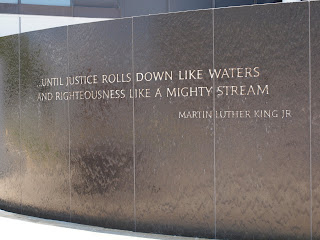From Memphis, TN we headed towards Selma, Alabama, in search of a place to sleep. Looking at our map, we decided to stay at a state park that looked to be only about 7 miles out of Selma. As we were driving down what we thought was the road that would lead us to the campsites, it seemed as though quite a bit of time had passed since we arrived in Selma. The sun was setting at this point, and we were now on a slippery red dirt road, and there were no lights or signs of life to be seen anywhere near us. A few times our van started sliding as if we were on ice, and we realized we were running low on gas. At this point, we both started to get nervous and wondered if we were going to either slide off of the road into a ditch or get stuck. The road was fairly narrow and there were no places to turn around. Not too far from where we were, there had been other forests/campsites that had been washed out from the rain! Although Guy remarked how calm I seemed, I was totally starting to freak out at this point. We were miles from anything or anyone and the situation did not look promising. We ended up finding a decent place to try turning around, which Guy did successfully, and started back towards civilization. When we hit the pavement again, we saw a sign for the state park, but it had closed just a half an hour earlier. I was so thankful we made it out of the scary forest, I didn’t even care that we still had to find a place to sleep.
As we headed into town - there it was - the huge “Walmart” sign. We pulled into the lot and decided to stay there for the night. The only other time we stayed at a Walmart on this trip (or ever) was back in Peyson, AZ, and it was NOT an enjoyable experience for me. I was hopeful this round would be better. It wasn’t. It was so hot and humid that night, I probably got about two hours of actual sleep that night. The only thing that comforted me that night was the fact that I wasn’t lying in a ditch in the middle of the forest.
So, enough about my campsite/no sleep ramblings…and back to the real point of this blog - the journey from Selma to Montgomery. Before we left on this trip, I was so excited to go to Alabama to retrace the steps of this historic march, and I was not disappointed by the experience. In 1965, thousands participated in a 54-mile march from Selma, Alabama, to the state capitol in Montgomery, led by Martin Luther King. African Americans were discriminated against in many facets of every day living, including the right to vote. When attempting to register to vote, made up “rules” would inhibit them from registering - including limiting the number of applicants, or suddenly closing the doors of the facilities without explanation. Selma Alabama was extreme in its restrictions towards blacks, thus protestors decided to gather in the city in hopes of drawing attention of the president and gaining new voting rights legislation.
The first march was attempted on March 7, 1965, but after only 6 blocks peaceful marchers were met by hostile lawmen armed with teargas and billy clubs, violently attacking and stopping the march in an event known as “Bloody Sunday.” Just days later, MLK Jr. led another nonviolent march, this time calling for religious leaders around the nation to join in a prayful gathering at the sight of Bloody Sunday. This gained the attention of President Johnson who promised to introduce a voting rights bill to congress.
The third and final march was held a few weeks later (with the protection of hundreds of federal agents and the national guard) over a number of days, going the full 54 miles from Selma to Montgomery. The number of marchers totaled approximately 25,000, and they congregated on the steps of the Montgomery Capitol, where King delivered an inspiring speech. A few months later, President Johnson signed the Voting Rights Act of 1965 which authorized the attorney general to send federal examiners to replace local registrars if voting discrimination occurred.
We began retracing the steps of the march at the site where it all began - Brown Chapel in Selma. This church served as the headquarters for the Voting Rights Movement as well as the starting point for the march.
As we drove along the trail, we saw the campsites the marchers stayed at over the four days. At the half-way point, we visited the Lowndes County Interpretive Center which gave an excellent overview of the events leading up to the march, as well as the march itself, and the aftermath. When we arrived in Montgomery, it was amazing to stop and see both the Dexter Avenue King Memorial Baptist Church where MLK Jr. served as pastor, and to stand on the steps of the the capitol where he delivered his speech to all of those thousands of everyday heroes.
Before leaving Montgomery, we stopped at the Civil Rights Monument - a beautiful sculpture and fountain that simply read “…until justice rolls down like water and righteousness like a might stream.”
It proved to be a very moving and powerful afternoon spent reflecting on the struggles and triumphs of the Civil Rights Movement.








No comments:
Post a Comment